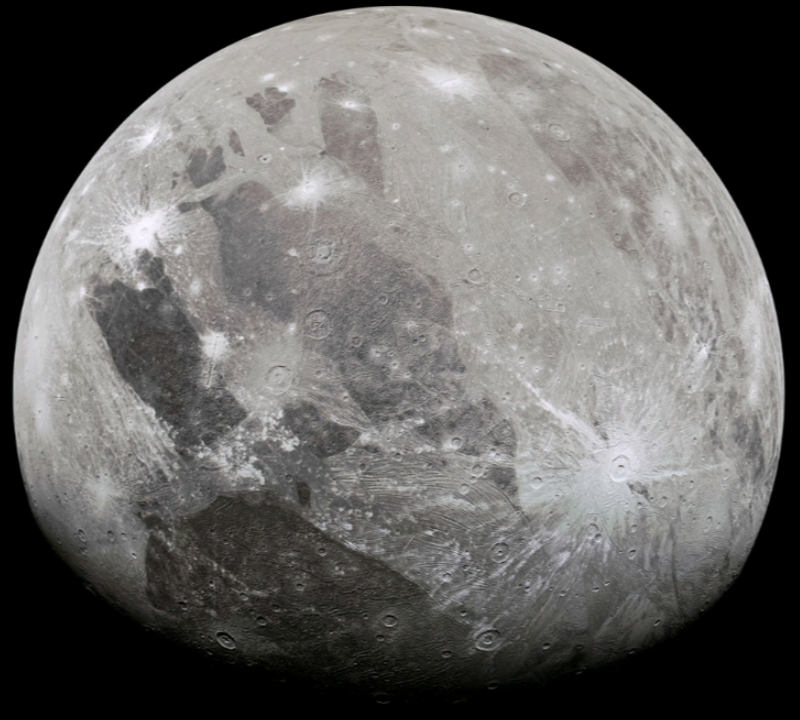Jupiter’s Moon Ganymede, which was named after a Trojan prince in Greek mythology, actually has a sound, according to NASA; unfortunately, it doesn’t sound like Greek music but rather emits an odd stream of sounds that is reminiscent of the earliest days of the internet.
NASA compiled an audio track of the sounds given off through space by the moon that orbits our solar system’s largest planet, which seems to be sending a strange, ethereal message through space.

On June 7, 2021, NASA’s spacecraft “Juno” made its closest approach to Ganymede, which is the largest moon anywhere in the solar system. The frozen moon, which is larger than the planet Mercury is large enough to have its own magnetic field.

.
Ganymede has a “song” that is alternately silly, ethereal
While flying past the natural satellite, Juno recorded the sound of Ganymede’s electromagnetic waves, compiling the results to reveal the song of the moon, as reported by Science Alert.
Listening to the sounds emitted by the planet is a bit of a spine-tingling experience; the 50-second-long audio track seems to reach out to us through the millions of miles of space after researchers converted it to a sound frequency that humans can hear.
First heard during the Fall meeting of the 2021 American Geophysical Union, the sounds emitted by Ganymede were picked up by Juno as it swept a mere 645 miles over the surface of the Jovian moon.
Although it was traveling at a blistering 41,600 miles per hour, Juno swooped 645 miles above Ganymede’s surface to capture the audio, according to Science Alert. Using an instrument called “Waves,” it captured the sounds by measuring radio and plasma waves in the magnetosphere of Jupiter. Waves instrument was designed to help scientists further understand the interactions between the planet’s magnetic field, atmosphere, and magnetosphere.
A sharp change in frequencies which is heard around the mid-point of the recording led researchers to believe that that was the point at which Juno may have entered a different part of Ganymede’s magnetosphere.
Ganymede mission will help astronomers understand moon’s composition, icy exterior
William Kurth, an investigator for the Waves instrument who is based at the University of Iowa in Iowa City, told Live Science in a statement that the tonal shift may have happened at the moment when Juno raced past the moon’s night side and entered the side closest to the sun.
“This soundtrack is just wild enough to make you feel as if you were riding along as Juno sails past Ganymede for the first time in more than two decades,” declared Scott Bolton, an experimental space physicist who is Juno’s principal investigator, in a statement.
“If you listen closely, you can hear the abrupt change to higher frequencies around the midpoint of the recording, which represents entry into a different region in Ganymede’s magnetosphere,” he explained.
Since it is by far the largest planet, Jupiter’s enormous magnetosphere, which is the most most powerful anywhere in the solar system, interacts with Ganymede’s own magnetic field, which emanates from its liquid iron core, according to Engadget.
Galileo spacecraft first explored Ganymede, sampling its sound in 2017
Ganymede is the only one of Jupiter’s moons that was named after a male figure from Greek mythology; it circles the planet every seven days, along with the smaller moons named Io, Europa and Callisto.
The new research will give astronomers a better understanding of Ganymede’s crust, which is made up of ice, as well as its magnetic field, as a way to help prepare for future missions to Jupiter, National Public Radio reports.
Scott Bolton, Juno’s principal investigator at the Southwest Research Institute in San Antonio, Texas, said in a statement “Juno carries a suite of sensitive instruments capable of seeing Ganymede in ways never before possible.
“By flying so close, we will bring the exploration of Ganymede into the 21st century, both complementing future missions with our unique sensors and helping prepare for the next generation of missions to the Jovian system.”
NASA’s earlier Galileo spacecraft, which toured space around the Jovian planet in the 1990s and early 2000s, detected plasma waves around Ganymede that were one million times stronger than those around Jupiter, according to a report from Science Alert.
Ganymede’s magnetic field is strong enough to make hole inside Jupiter’s own magnetosphere, which incredibly creates a tiny magnetosphere within Jupiter’s, according to a study published in the Cambridge University Press in 2004.
As of now, researchers continue to try to glean more information from the audio track of Ganymede. At the meeting, researchers also revealed the most detailed map of Jupiter’s magnetic field from data that had been collected by Juno, as well as more details on Jupiter’s intriguing Great Blue Spot, Science Alert reports.
Five years ago, NASA’s Galileo, the first vehicle to orbit an outer planet, took the first audio sampling of Ganymede’s magnetosphere, picking up some noises which are almost reminiscent of tropical birds — along with the much more prosaic internet-like burbles and chirps.
Ganymede was named after the handsome son of King Tros, whom Jupiter transported to heaven on his back.






